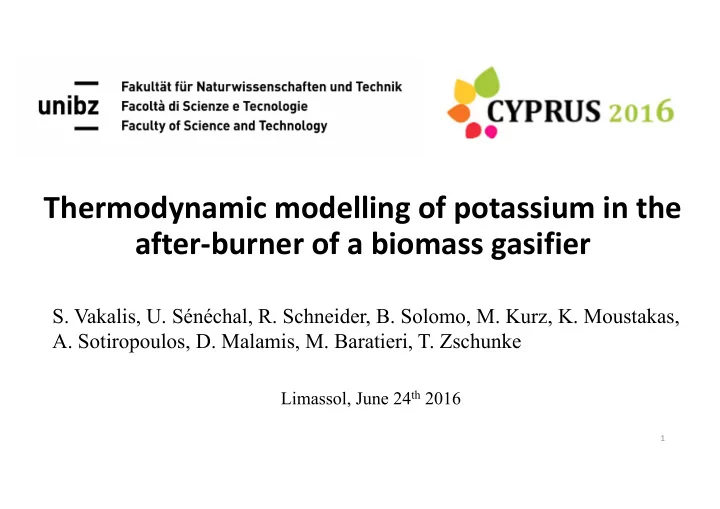

Thermodynamic modelling of potassium in the after ‐ burner of a biomass gasifier S. Vakalis, U. Sénéchal, R. Schneider, B. Solomo, M. Kurz, K. Moustakas, A. Sotiropoulos, D. Malamis, M. Baratieri, T. Zschunke Limassol, June 24 th 2016 1
Concept of gasification Gasification is a thermal process which under sub- stoichiometric conditions “packs” energy into chemical bonds Tar, Dust, Ash, Soot Fuel Syngas (C – rich) or Gasification Producer gas λ < 1 Gasifying medium Char (air, O 2 , CO 2 ) 2
Syngas - Producer gas Syngas CO, H 2 Producer gas CO , H 2 , CO 2 , CH 4 but also N 2 3
Other by-products Tar - heavy organic compounds Char – high in carbon Ash – inert minerals Dust - Soot 4
Char characteristics and management Char is a carbon rich Management of the residue char remains an imporant material and its structure is problem in the small scale gasification sector. similar to graphite The main reason is the concentration of heavy metals. Solutions to the problem should be developed on a local level or even better onsite, since the amount of produced char from small scale gasifiers is not sufficient in order to provide incentives for more centralized projects. 5
Gasifier with an onsite application • Joos gasifier • Two separate vessels • 30 kWe, 80 kWth • Main product: producer gas • 23 – 25 % el. Efficiency • 70 % CHP efficiency • 2 – 5 % char as by - product Source: Spanner RE website 6
The introduction of an after- burner GASIFIER FILTER AFTER- BURNER PRODUCTS CHAR Char reacts on a secondary stage with air at an elevated temperature (450 °C – 750 °C). The scope is the distribution of heavy metals between the gaseous and the solid phase. Usually a reduction > 20 % is sufficient for reduction into accepted environmental limits. 7
Benefits of after-burner integration The content of heavy metals is correlated to the quality of the input. After gasification their concentration increases by orders of magnitude. As a result, char may be potentially treated as hazardous waste. The integration of an after-burner assists: • Reduction of char volume • Reduction of heavy metals and alkali metals content • Reduction of tar compounds trapped in the solid residue 8
Modelling the after - burner • Optimization of the after – burner has the scope to minimize simultaneously char - tar – metals contents • A commercial software was utilized for modelling the equilibriums of heavy and alkali metals. (Master Thesis of Barbora Zezulova) • The commercial software provided very interesting results concerning the thermodynamic equilibriums of all the investigated heavy and alkali metals. • Nonetheless, several issues had to be taken into cosideration for the case of the after-burner. 9
Issue 1 - Yield of carbon Predicted elements gas/liquid/solid phase 650 ° C 100% 90% 80% moles per mole fuel C 70% 60% Solid 50% Liquid 40% Gas 30% 20% 10% 0% 10
Issue 2 – Gas composition Equilibrium concentrations of gas species 0,45 Mole fraction, dry basis CO2(g) 0,4 0,35 N2(g) 0,3 O2(g) 0,25 0,2 H2(g) 0,15 CO(g) 0,1 0,05 CH4(g) 0 600 700 800 900 1000 1100 1200 Temperature, C 11
Issue 3 – Air input in the after-burner Air input can be measured by means of a Pitot tube. Nonetheless, the input is separated in two streams in order to cover the operation of the gasifier and the operation the after-burner. The air that enters the after- burner can be only indirectly calculated. 12
Introduction of thermodynamic model • MATLAB/ Cantera model • Databases: GRI-Mech, NASA • Mechanisms: KOH.cti., graphite.cti, gri30.cti • 3-phase model with char phase represented by graphite and potassium/ potassium oxides is represented by the KOH.cti 13
Solid – Liquid – Gas equilibriums of metals Predicted elements gas/liquid/solid phase 650 ° C 100% 90% 80% 70% 60% Solid 50% Liquid 40% Gas 30% 20% 10% 0% Al Ba Ca Cl Cr Cu Fe K Mg Mn Na P S Si Sr Ti Zn element i 14
Fundamental concept of the model • The balance of char is used as a control variable in order to assess the amount of reactive oxygen. • Potassium yield is calculated for different temperatures. • Gaseous species are calculated in accordance Monitoring of a Spanner gasifer was used for verification of results • Spanner HK30 • Hochschule Zittau/ Görlitz • Measurements follow the ‘Recommendation CTI 13‘ 15
Results – Char residue yield 16
Results- Solid pottasium (K) yield 17
Results - Gaseous species (ER 0.25) 0,4 0,35 molar fraction (%) 0,3 0,25 0,2 0,15 0,1 0,05 0 600 700 800 900 1000 1100 1200 Temperature (°C) CO CO2 18
Comparison of results (at 650 °C/ 0.25 ER) Commercial Cantera model Case study software Char Yield 0% 75 % 79.5 % Potassium Yield 78 % 72 % 70.2 % Gaseous Species Primarily carbon Transition to carbon n.a. dioxide at all monoxide above 700 temperatures °C 19
Conclusions • The utilization of an after-burner is a unique commercial application that is financially sustainable. • Modelling the after-burner may result to the optimization of the process • The Cantera model was able to return more reliable results for the estimated char yield, potassium yield and the composition of the main gaseous species in comparison to the commercial software. • It should be denoted that this model aims only to assist and not to replace commercial softwares. 20
THANK YOU FOR YOUR ATTENTION! For further info: stergios.vakalis@outlook.com 21
Recommend
More recommend